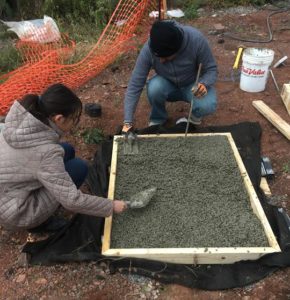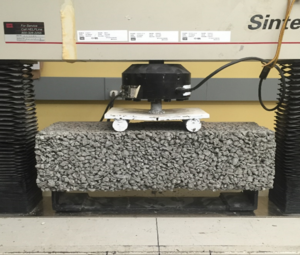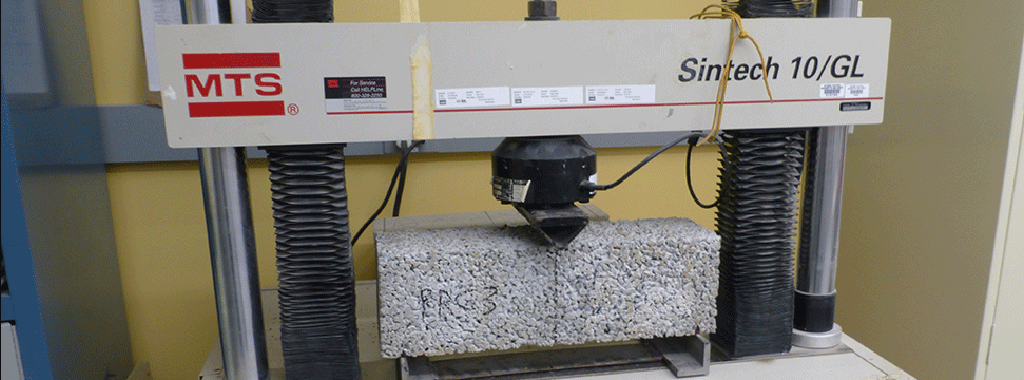In December 2017, a team of researchers at the Center for Advanced Infrastructure and Transportation (CAIT) at Rutgers University published a research study for NJDOT on “The Use of Porous Concrete for Sidewalks.” A porous concrete sidewalk typically consists of a porous concrete slab on top of an open graded stone reservoir layer. A filter fabric is placed between the underlying soil and the reservoir layer. One of the most important benefits of porous concrete is its effectiveness for stormwater management, i.e. improving water runoff quality, reducing stormwater runoff, and restoring groundwater supplies. However, there are concerns related to its construction, cost, maintenance, and durability.

Rodding and finishing of a porous slab. Photo source: Najm, 2017.
The primary objective of the research study was to evaluate the various factors that influence the performance of porous concrete in sidewalks. These include hydraulic performance to meet New Jersey Department of Environmental Protection (NJDEP) regulations and structural performance to meet typical sidewalk strength requirements as well as life-cycle cost and maintenance requirements. The researchers compared the performance of porous concrete in sidewalks with other materials, such as conventional concrete and asphalt alternatives, and tested various pervious concrete mixes to evaluate the hydrological and structural performance and energy budget versus conventional concrete mixes. The team also conducted a cost benefit analysis for use of porous concrete on sidewalks versus alternatives. The study resulted in recommendations and guidelines that NJDOT could use to inform the mitigation of stormwater runoff and development of maintenance standards.
The study found that the effectiveness of porous concrete in reducing stormwater runoff could contribute to cost savings. The research report examined a number of important considerations affecting the broader implementation of this technology. A life-cycle cost analysis of three sidewalk design alternatives—porous concrete, porous asphalt, and conventional concrete—found that porous concrete had the highest initial construction cost, with conventional concrete coming in slightly less, and porous asphalt being the cheapest. The study showed that the service life of porous concrete may be shorter than conventional concrete, driving up the life-cycle cost and potentially offsetting the savings from stormwater management best practices. For porous asphalt, which has the shortest service life, findings showed that if the service life ratio of porous asphalt compared to conventional concrete was greater than 0.60, then porous asphalt would be the most economically competitive option of the three. Another consideration in some areas is that it may be less effective to implement porous pavement if the soil has low permeability. The report notes that, once implemented, periodic maintenance is required to prevent clogging from debris and sediments, and freezing in the winter to avoid failure due to freeze and thaw cycles.

Porous concrete beam during flexural test. Photo source: Najm, 2017
The research team recommended that next steps should include construction of a porous concrete sidewalk and a porous asphalt sidewalk for long- and short-term performance testing. They noted that implementation should include geotechnical evaluation of the subsoil layers for infiltration rates, hydraulic design and storm-runoff analysis, selection of porous mix design based on NJDOT specifications and contractor recommendations, sample prisms and cylinders extracted for lab tests, scheduled maintenance based on NJDEP and NJDOT guidelines, and regular inspection. While there are environmental benefits to the implementation, such as filtration of contaminants like metals, oils and grease, to improve water quality and reduce chloride pollution, there are also concerns it can cause groundwater contamination. These concerns, along with recommended further performance testing, highlight the importance of interim steps before wider implementation.
Pervious pavement is a key component of green infrastructure methods that seek to improve stormwater management. The New Jersey Department of Environmental Protection lists the practice among others such as rain barrels, cisterns, and rain gardens/bioretention basins as strategies that can be implemented on a variety of scales in order to both treat runoff and reduce runoff volume. Yet, as the report notes, there has been little published research on performance and practical experience in the United States, highlighting the researchers’ final recommendation for further testing.
Sources
Green Infrastructure in New Jersey. (2018). Retrieved from https://www.nj.gov/dep/gi/More_Info.html
Najm, H., Wang, H., Miskewitz, R., Roda, A. M., Ali, A., He, H., Chen, X., Hencken, J. (2017). The Use of Porous Concrete for Sidewalks. Retrieved from https://www.state.nj.us/transportation/refdata/research/reports/FHWA-NJ-2018-001.pdf
Najm, H., Wang, H., Miskewitz, R., Roda, A. M., Ali, A., He, H., Chen, X., Hencken, J. (2017). Technical Brief: The Use of Porous Concrete for Sidewalks. Retrieved from https://www.state.nj.us/transportation/refdata/research/reports/FHWA-NJ-2018-001-TB.pdf

